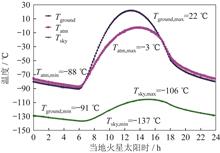The thermal control technology for Mars surface takeoff and ascent is a key technology for Mars sample-return exploration,involving the temperature control for storage,the temperature control for Mars surface takeoff and ascent,andthe temperature control for Mars in-orbit flight.It has the characteristics of high temperature index requirements,large temperature control dimensions,and scarce resources.In this paper,the thermal control schemes of major Mars roversat home and abroad and the Mars ascenders ofthe National Aeronautics and Space Administration (NASA)are investigated and summarized.The results show that,according to the resource allocation,the thermal control technology of Mars surface probes mainly adopts two strategies.When the thermal control weight is not significantly limited,aiming at the reuse of waste heat,the mechanical pump driven fluid circuit technology is adopted to collect and transfer the heat of high heat consumption devices,in conjunction with conventional thermal control measures.When the thermal controlweight is severely limited,lightweight and low-power thermal control measures should be adopted.At this time,aiming at the lowest power consumption,the composite nano-aerogel thermal insulation technology is usually adopted to efficiently isolate the low-temperature convective environment on the surface of Mars,in combination with conventional thermal control measures.Subsequently,the key thermal control technologies for Mars surface takeoff and ascent are proposed,mainly includingthe nano-aerogel thermal insulation technology,the thermal insulation technology for in-situ resources on Mars,the mechanically pumped two-phase loop (MPTL) technology,the atmospheric dynamic thermal protection technology,and the thermal test simulation technology,which can provide some reference for subsequent Mars exploration.
The atmosphere of planets is a crucial research orientation in fields such as deep space exploration and space astronomy,among which the ultraviolet (UV) spectral range is a significant aspect of planetary atmospheric activity research.To obtain UV spectrum information from various extraterrestrial planets,international research teams have conducted relevant technological studies over the past few decades,and have developed numerous scientific observation payloads.In this paper,the development of planetary UV spectrum detection payloads are reviewed,and the advancement and iteration of the spectrometer technology driven by the progress in the core UV component technologies are analyzed.Finally,possible future directions and key research areas in the field of planetary UV spectrum detection are presented.
According to the white paper “China's Aerospace 2021”,China's planetary exploration project will carry out asteroid exploration,Mars sampling return,and Jovian system exploration,but there is no clear plan for more long-term planetary exploration missions.The Saturn is the second largest planet in the solar system,with beautiful rings and many natural satellites,among which the Enceladus may have a subglacial ocean,and the Titan is the second largest natural satellite in the solar system and the only satellite with a dense atmosphere,all of which are of great scientific research value.In this paper,foreign Saturn exploration missions are investigated and analyzed,including Pioneer 11,Voyager 1,Voyager 2,and Cassini-Huygens,as well as the future missions,including Enceladus Orbilander and Enceladus Multiple Flybys.The characteristics of these missions and the key difficulties in the implementation of Saturnian system exploration are summarized.Finally,an overall mission assumption of Saturn system exploration is proposed,and the mission analysis and preliminary design are carried out,which can be used as a reference for China's follow-up planetary exploration mission planning.
A comprehensive overview for the latest progress of international deep space exploration mission design is presented,covering the fields of lunar exploration,major planetary exploration,and small celestial body exploration.In terms of lunar exploration,the strategic layouts of the Earth-Moon space,e.g.,the Artemis program in the United States and China's lunar exploration program,are demonstrated.In terms of major planetary exploration,the history and current status of the exploration missions for the Mercury,the Venus,the Mars,the Jupiter,the Saturn,and other outer planets,are reviewed.In terms of small celestial body exploration,the technical challenges and scientific significance are discussed,and the missions,such as flybys,orbits,sampling,and impacts,are expatiated.Based on these discussions,the enlightenment and development trends of deep space exploration missions are summarized,and relevant mission suggestions and concepts are put forward in combination with China's deep space exploration capability and the development of international planetary science,which could offer references for the design of future deep space exploration missions in China.
To address the problem of autonomous positioning for deep space probe,an optimal selection method of optical information under the fusion positioning of angle measurement and navigation satellite ranging is proposed.The characteristics of optical angle measurement and navigation satellite ranging are analyzed,and a fusion positioning scheme of angle measurement and navigation satellite ranging is designed to realize the high-precision absolute positioning.On this basis,in view of the measurement accuracy of the sensor and the measurement geometry,the overall observability and relative observability of the angle measurement information are designed,the evaluation function of the angle measurement information is constructed,and the heuristic algorithm is used to optimize the selection of the angle measurement combination.Finally,numerical simulation is carried out,and the obtained results show that the designed optical selection method of optical information can effectively improve the navigation performance.
The field of view for near Earth asteroids observed by ground-based astronomical telescopes is limited due to backlighting,while observing form a Venus-like orbit or at the Sun-Earth L1 point can provide better visible ranges.In this paper,a proposal is made to use microsatellites positioned at the Sun-Earth L1 point for monitoring near-Earth asteroids.The overall design of the mission microsatellites is described,the transfer orbit design is analyzed in detail,and a payload design scheme is provided.Through missions,several key technologies for deep space microsatellites are verified,including the overall design with large velocity increments using electric propulsion,the low-energy transfer orbit design for deep space,and the high-performance on-orbit processing of astronomical data,thereby exploring a cost-effective approach to deep space exploration.













